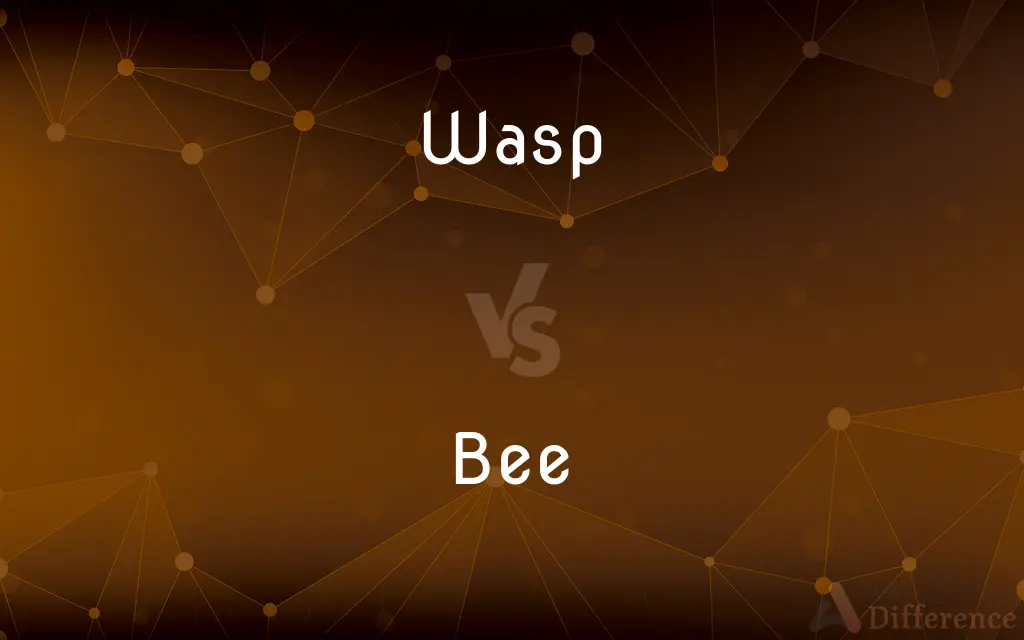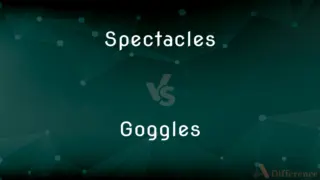Wasp vs. Bee — What's the Difference?
By Tayyaba Rehman — Updated on November 6, 2023
Wasps are generally predatory or parasitic and less hairy, while bees are pollinators with a more robust and hairy body adapted for collecting pollen.

Difference Between Wasp and Bee
Table of Contents
ADVERTISEMENT
Key Differences
Wasps can be identified by their pointed lower abdomens and a narrow “waist,” called a petiole, that separates the abdomen from the thorax. They are typically less hairy than bees and have a more diverse range of feeding habits, including predation and parasitism. Bees, conversely, have rounder bodies and are fuzzier, which aids in pollen collection. Their feeding habits are generally focused on nectar and pollen, and they are critical for the process of pollination.
Wasps are known for their more aggressive nature and ability to sting multiple times. They play various roles in the ecosystem, such as controlling pest populations. Bees are often less aggressive (except when provoked or defending their hive) and usually die after stinging because their barbed stinger gets lodged in the skin of their target. Bees are one of the major groups of pollinators in nature, aiding in the reproduction of flowering plants.
The social structure of wasps can vary greatly, from solitary to living in large colonies. Their nests are often made from paper-like materials and can be found in various locations. Bees, especially honeybees and bumblebees, tend to have highly organized social colonies with a clear division of labor. Beehives are constructed from wax and are typically more perennial than wasp nests.
Wasps can be omnivorous, feeding on other insects and sometimes human food, while bees are herbivorous, consuming only nectar and pollen. Wasps do not produce honey, but some species of bees are known for honey production, which is a significant food source for humans and other animals.
Both wasps and bees are important in their own right to the environment. Wasps are valuable as natural pest controllers, and bees are crucial pollinators that support both wild ecosystems and agricultural systems.
ADVERTISEMENT
Comparison Chart
Body Shape
Slender with a narrow waist
Plumper and more hairy
Stinger
Smooth, can sting repeatedly
Barbed, typically sting once and then die
Diet
Predatory, some species are omnivores
Primarily herbivores, feeding on nectar and pollen
Nesting
Paper-like nests, less permanent
Waxy hives, more permanent
Role in Ecosystem
Predators, control other insect populations
Pollinators, crucial for plant reproduction
Compare with Definitions
Wasp
Any member of the order Hymenoptera and suborder Apocrita that is neither a bee nor an ant.
The garden was home to many insects, including a brightly colored wasp.
Bee
A fuzzy-bodied insect adapted for gathering nectar.
The bee's hairy body helps it collect pollen from flowers.
Wasp
An insect known for its predatory behavior.
The wasp caught a caterpillar to feed its young.
Bee
Bees are often less aggressive unless their hive is threatened.
The bee only stung me after I accidentally disturbed the beehive.
Wasp
Some wasps are solitary, while others live in colonies.
That solitary wasp prefers to live alone, unlike bees that live in communities.
Bee
A flying insect known for its role in pollination.
A bee landed on the sunflower, collecting pollen.
Wasp
A slender insect with a narrow waist and a sting.
A wasp buzzed by, searching for a place to land.
Bee
An insect that produces honey.
The bee returned to the hive to make honey.
Wasp
A wasp is any insect of the narrow-waisted suborder Apocrita of the order Hymenoptera which is neither a bee nor an ant; this excludes the broad-waisted sawflies (Symphyta), which look somewhat like wasps but are in a separate suborder. The wasps do not constitute a clade, a complete natural group with a single ancestor, as their common ancestor is shared by bees and ants.
Bee
A member of a highly social and structured colony.
Each bee in the colony has a specific job.
Wasp
A white person of Protestant English or other Northern European ancestry, especially one belonging to the American upper class.
Bee
Bees are insects with wings closely related to wasps and ants, known for their role in pollination and, in the case of the best-known bee species, the western honey bee, for producing honey. Bees are a monophyletic lineage within the superfamily Apoidea.
Wasp
A member of Women's Airforce Service Pilots, organized during World War II as part of the US Army Air Forces to ferry aircraft and to test new aircraft. The organization was disbanded in 1944.
Bee
Any of numerous winged, hairy-bodied, usually stinging hymenopteran insects of the superfamily Apoidea, including both solitary species and social species such as the honeybees, and characterized by sucking and chewing mouthparts for gathering nectar and pollen.
Wasp
Any of numerous social or solitary hymenopterans of the suborder Apocrita, especially of the family Vespidae, that characteristically have a slender hairless body with a constricted abdomen, two pairs of membranous wings, a mouth adapted for biting or sucking, and in the females an ovipositor sometimes modified as a sting.
Bee
A gathering that combines cooperative labor and social interaction or friendly competition
A quilting bee.
Wasp
Any of many types of stinging flying insect resembling a hornet.
Bee
A competition in which contestants are eliminated one by one after failing to answer a question or solve a problem
A spelling bee.
Wasp
(entomology) Any of the members of suborder Apocrita, excepting the ants (family Formicidae) and bees (clade Anthophila).
Bee
A bee block.
Wasp
Any of the members of the family Vespidae.
Bee
The letter b.
Wasp
A person who behaves in an angry or insolent way, hence waspish.
Bee
A flying insect, of the clade Anthophila within the hymenopteran superfamily Apoidea, known for its organised societies (though only a minority have them), for collecting pollen and (in some species) producing wax and honey.
Wasp
Alternative case form of WASP
Bee
A contest, especially for spelling; see spelling bee.
Geography bee
Wasp
To move like a wasp; to buzz
Bee
A community gathering to share labour, e.g. a sewing bee or a quilting bee.
Wasp
Any one of numerous species of stinging hymenopterous insects, esp. any of the numerous species of the genus Vespa, which includes the true, or social, wasps, some of which are called yellow jackets.
Bee
(obsolete) A ring or torque; a bracelet.
Wasp
A white person of Anglo-Saxon ancestry who belongs to a Protestant denomination
Bee
Any of the pieces of hard wood bolted to the sides of the bowsprit, to reeve the fore-topmast stays through.
Wasp
Social or solitary hymenopterans typically having a slender body with the abdomen attached by a narrow stalk and having a formidable sting
Bee
Obsolete spelling of be
Wasp
A stinging insect, often more aggressive than bees.
A wasp can be more dangerous because it can sting multiple times.
Bee
(obsolete) be; been
Cride out, Now now Sir knight, shew what ye bee,
Bee
An insect of the order Hymenoptera, and family Apidæ (the honeybees), or family Andrenidæ (the solitary bees.) See Honeybee.
Bee
A neighborly gathering of people who engage in united labor for the benefit of an individual or family; as, a quilting bee; a husking bee; a raising bee.
The cellar . . . was dug by a bee in a single day.
Bee
Pieces of hard wood bolted to the sides of the bowsprit, to reeve the fore-topmast stays through; - called also bee blocks.
Bee
Any of numerous hairy-bodied insects including social and solitary species
Bee
A social gathering to carry out some communal task or to hold competitions
Common Curiosities
What is the primary difference between a wasp and a bee?
Wasps are generally more slender and less hairy than bees, which are robust and have more hairs to collect pollen.
Do both wasps and bees die after stinging?
No, only bees die after stinging as their stingers are barbed and get stuck in the skin.
Do wasps produce honey?
No, wasps do not produce honey; this is a characteristic activity of some bee species.
Are all bees able to sting?
Most bees can sting, but male bees, called drones, do not have stingers.
Which is more aggressive, a wasp or a bee?
Wasps are generally more aggressive than bees.
Can both wasps and bees sting?
Yes, but bees can usually sting only once as they die after stinging, whereas wasps can sting multiple times.
Can the words 'wasp' and 'bee' be used interchangeably?
No, they refer to different families of insects and have distinct behaviors and physical attributes.
Do both wasps and bees have queens?
Yes, in social species of both insects, there is typically a queen responsible for reproduction.
Are wasps and bees both important to the environment?
Yes, both play crucial roles; bees are known pollinators, and wasps are predators that help control pest populations.
Can wasps produce honey?
No, wasps do not produce honey; that is a characteristic of some bee species.
Are wasps or bees more aggressive?
Wasps are generally more aggressive and likely to sting than bees.
Are all bees and wasps social insects?
Many bees and wasps are social and live in colonies, but there are also solitary species.
Is the bee population declining?
Yes, many bee populations are declining due to factors like habitat loss, pesticides, and disease.
Do both wasps and bees play a role in pollination?
Bees are primary pollinators, but wasps also contribute, albeit to a lesser extent.
Share Your Discovery

Previous Comparison
Fable vs. Folktale
Next Comparison
Spectacles vs. GogglesAuthor Spotlight
Written by
Tayyaba RehmanTayyaba Rehman is a distinguished writer, currently serving as a primary contributor to askdifference.com. As a researcher in semantics and etymology, Tayyaba's passion for the complexity of languages and their distinctions has found a perfect home on the platform. Tayyaba delves into the intricacies of language, distinguishing between commonly confused words and phrases, thereby providing clarity for readers worldwide.
















































